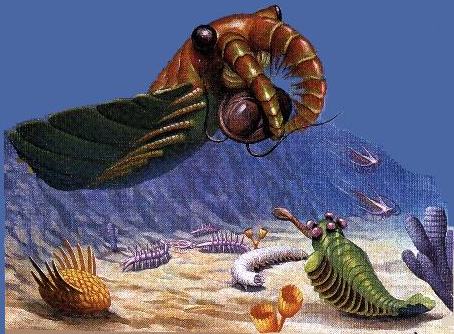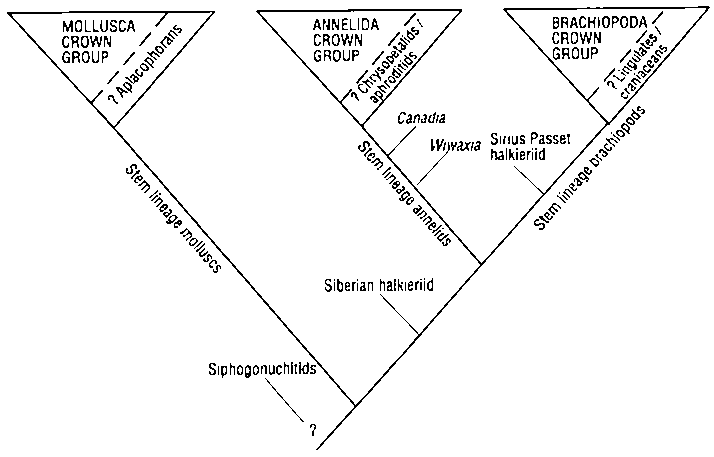
By Prof. Simon Conway Morris FRS, Professor of Evolutionary Paleobiology, University of Cambridge.
This page updated 16 March 2000.
This is a truly amazing book, and one which deserves to be widely known and read. Unlike the pundits whose writings on evolution dominate popular consciousness, Prof. Conway Morris is a real expert and a truly world-class scientist. He played a major role in the modern exploration and understanding of the Burgess Shale, was the first paleontologist to explore the Sirius Passet locality in Greenland, and was elected a Fellow of the Royal Society in 1990, at the remarkably young age of 38.
The chapters in the book deal with:
I have given as a 'taster' a long extract from the discussion in:

All science is embedded in a framework, which provides the points of reference and stability to our enterprise…the fact of organic evolution in itself is not in dispute..[but what is it that excites] continuing debate and disagreement? At heart there are two areas of contention: those of mechanism and those of implication. The first is a scientific problem, the second metaphysical.
…In all the debates and disagreement,… for the most part it is almost forgotten that evolution is a historical process. In part it is accessible from the fossil record…it is all the more remarkable that the pitfalls and fallacies that a well-trained historian teaches others to avoid do not seem to be utilised by those investigating the parallels in the history of life. In a society stricken by post-Sassurean relativism it is also too often forgotten that history had a unique course, and that in principle it is knowable.
These problems cannot be ignored, and in a culture that has almost entirely lost its way scientists should not be so naïve as to thank that today's literary aspirations will not colour their outlook. Thus, while the study of the interactions of science in the nineteenth century and the parallel creative expression of paintings, poetry, and novels are yielding rich dividends, the gulf between sciences and the arts in this century appears to be far deeper as each appears to pursue apparently unrelated programmes. Yet I suspect that the creeping relativism seen in so much of the arts and philosophy, linked to the poisonous ideas of such individuals as Derrida, are far more influential than is widely acknowledged. Is it any coincidence that some of the most celebrated popularisers of science, such as Stephen Hawking and Richard Dawkins, offer us such arid manifestos? Even a close reading of the last member of this triumvirate, Stephen Gould, beneath the hyperbole and enthusiasm, reveals a much bleaker message (see my review of Bully for Brontosaurus in the Times Literary Supplement, 13 December, 1991 p. 6). Recovery of the connections between the arts and science is one of our greatest, if un-acknowledged, challenges. One step in this direction would be a re-examination of literary theory, and highly recommended as a vigorous antidote to present trends is the book by Raymond Tallis entitled Not Sassure: a critique of past-Sassurrean literary theory (Macmillan, London 1998). A further exploration of the wider topic of the place of science by the same author is Newton's Sleep: the two cultures and the two kingdoms (St Martin's Press, New York, 1995) although in this case I find much to disagree with.

…Recent research into the developmental processes in animals has been … spectacular. At first sight these results seem to be consistent with the primacy of the gene … One of the best known examples involves a so-called master control gene which plays a key role in the formation of eyes … But this and similar genes hold further surprise which suggest the story to be more complicated. First, it transpires that the same gene (Pax-6 and its homologue eyeless) is employed not only in flies and other insects to build their compound eyes, but also in vertebrates. ... Yet … there are profound differences between the eyes of fly and Man … Most probably the Pax-6 gene is very ancient … [and] may pre-date the earliest animals. This is because its function is to create a light-sensitive unit … Pax-6 … tells us nothing about the manifest differences between the eyes with which we see the fly, and the eyes of the fly which observe us as we advance, rolled newspaper in hand.
It is in this manner that Dawkins' world-view is not so much wrong, as simply seriously incomplete…at the moment we have almost no idea about how form actually arises from the genetic code…It is certainly difficult to see how the severely reductionist approach of Dawkins will…provide the most satisfactory strategy. Indeed what has quite unexpectedly emerged is how seemingly very different organisms have in common fundamentally the same genetic information. Here is perhaps the central paradox of genes and evolution: vast contrasts in morphology and behaviour need have no corresponding differences in the genetic code.
Perhaps a suitable analogy to explain the short-fall of Dawkins' account
of evolution is to think of an oil painting. In this analogy Dawkins has
explained the nature and range of pigments; how the extraordinary azure
colour was obtained, what effect cobalt has, and so on. But the description
is quite unable to account for the picture itself. This view of evolution
is incomplete and therefore fails in its side-stepping of how information
(the genetic code) gives rise to phenotype, and by what mechanisms. Organisms
are more than the sum of their parts, and we may also note in passing that
the world depicted by Dawkins has lost all sense of transcendence.

Many of the animals from the Burgess Shale and similar deposits look, to our eyes, to be very peculiar. It has been thought that many of these animals were so odd ... that there was no possibility of including them in any known phylum ... in the opinion of scientists such as Steve Gould, so great was this 'explosion' that it is perhaps futile to invoke any of the normally accepted mechanisms of evolution ... What this chapter will try to show is that the strangeness of the problematic Cambrian animals is really a human artefact. How can we be so optimistic..? Here I shall introduce two case studies that seem to dispel some of the mystery that has surrounded these pecular-looking animals. If these examples are accepted, then there is surely good reason to think they have a general applicability to our understanding of the Cambrian 'explosion'. {Prof. Conway Morris then explains the reason why we should consider a set of evolutionary relationships as illustrated in the diagram to the right}

[But] this whole argument ... is based on a basic confusion concerning the destiny of a given lineage...versus the likelihood that a particular biological property or feature will sooner or later manifest itself as part of the evolutionary process ... Nearly all biologists agree that convergence is an ubiquitous feature of life. [In a footnote he remarks that: The constraints on life, and the ubiquity of convergence may re-open in an interesting fashion the arguments for Design] ... The point I wish to stress is that again and again we have evidence of biological form stumbling on the same solution to a problem. Consider animals that swim in water...there are only a few fundamental methods of propulsion. It hardly matters if we ...illustrate.. by reference to water beetles, pelagic snails, squid, fish, newts, ichthyosaurs, snakes, lizards, turtles, dugongs or whales...the style in which the animal moves through the water will fall into one of only a few basic categories.
...the long history of mankind is studded with convergences, perhaps most notably in social systems and the use of artifacts and technology. But for human history, set in the arrow of time, there appears to be one intolerable stumbling block. This is the catastrophic failure of human values and decency ... no scientific analysis can even remotely answer or account for past and present horrors of human behaviour. It is my opinion that human history can make no sense unless evil doings are recongnised for what they are, and that they are bearable only if somehow they may be redeemed.
So let us finally return to all those apparently strange and bizarre animals
in the Burgess Shale. It is the belief of Steve Gould that these fossils could
well undermine our conventional view of evolution ... [but] his first argument,
that the problematic fossils have such distinctive body plans that they must
represent extinct phyla, is misleading..[and] if a fly and a mouse have body
plans that are laid down by the same fundamental instructions, then it is perhaps
less likely that the self-evident differences in anatomy stem from really radical
differences in genetic architecture.
[he does not mention here - although I think he does somewhere else,
that
4a. the existence of Jupiter seems pretty essential in protecting
the Earth from much more intense meteor bombardment, which would wipe out
most of life before it had time to evolve much]
5. ...The Moon may be very unusual. In addition to maintaining the axial
stability of the Earth it has also been an important ingredient in making the
Earth inhabitable. See What
if the Moon didn't exist?.
[6. another point Prof Conway Morris does not mention explicitly
(because the papers were published in late 1998) is that all the evidence
suggests that the process of planetary formation is highly chaotic, with
planets throwing eachother around and ejecting some members (see
Nature 10 Dec 98 pp513-514) and that simulations suggest that nearly circular
orbits such as those in the Solar System are highly unlikely (Nature 3
Dec 1998 pp413-414). However without a nearly circular orbit conditions
on a planet would not allow evolution of life, because it would be too
hot and too cold once a year.]
Prof Conway Morris strongly commends SL Jaki's books God
and the Cosmologists and Is
there a Universe?.

|
|
|
|
|